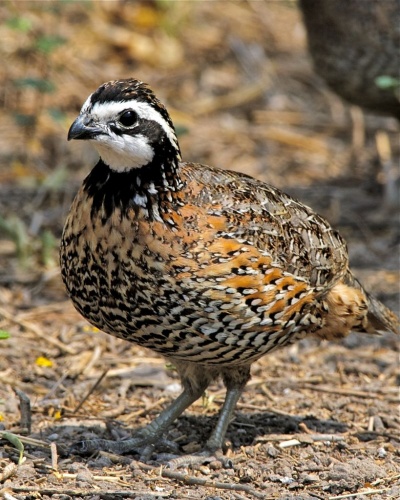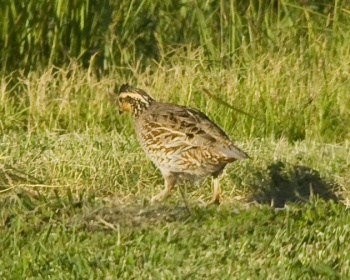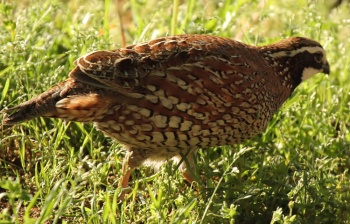- Colinus virginianus
Identification
20–28 cm (7¾-11 in)
Male
- White chin and supercilium
- Black cap, eyeline, nape and throat
- Reddish-brown body stippled with white and black spots
- Pale belly
Female
- Buff throat and supercilium
- Dark cap, eyeline, nape and throat
- Reddish-brown body
- Darker back
- Black and white streaks and chevrons about underparts and back
- Pale belly
Distribution
The North American range extends from southern Maine and Ontario south to Florida and west to the eastern fringes of Wyoming, Colorado and New Mexico. In extreme south-central Arizona into Mexico, there is an endangered subspecies, the Masked Bobwhite (C. v. ridgwayi), which once ranged from south-central Arizona to Sonora, Mexico.
With reintroduction programs, it now inhabits extreme southern Arizona and parts of Mexico. There are isolated populations of these game birds in parts of Idaho, Oregon and Washington states, where they have been introduced for hunting. They have also been introduced to southern British Columbia and parts of Hawaii.
In Mexico, found in the northeastern state of Tamaulipas southward to the Isthmus of Tehuantepec. In central Mexico it reaches further west, reaching the Pacific Ocean in southern Mexico. The species just reaches Guatemala.
On the Yucatan Peninsula it is replaced by Black-throated Bobwhite (Colinus nigrogularis).
Introduced populations also occur in Cuba, Haiti, the Dominican Republic, Italy, Germany and New Zealand.
Taxonomy
Subspecies
There are numerous subspecies, not all recognised by all authorities[1],[2]:
virginianus Group
- C. v. marilandicus: North-eastern US (south-eastern Maine to Pennsylvania and central Virginia)
- C. v. virginianus: Atlantic coast (Virginia to northern Florida and south-eastern Alabama)
- C. v. floridanus: Peninsular Florida
- C. v. cubanensis: Cuba and Isle of Pines
- C. v. mexicanus: Eastern US west of Atlantic seaboard to Great Plains
- C. v. taylori: South Dakota to northern Texas, western Missouri and north-western Arkansas
- C. v. texanus: South-western Texas to northern Mexico (Coahuila, Nuevo Le¢n, Tamaulipas)
- C. v. aridus: Eastern Mexico (central and west-central Tamaulipas to south-eastern San Luis Potos¡)
- C. v. maculatus: Eastern Mexico (central Tamaulipas to northern Veracruz and south-eastern San Luis Potos¡)
graysoni Group
- C. v. graysoni: West-central Mexico (southern Nayarit to Morelos, southern Hidalgo, San Luis Potos¡)
- C. v. nigripectus: Eastern Mexico (Puebla, Morelos and Mexico)
pectoralis Group
- C. v. pectoralis: South-eastern Mexico (eastern slopes of mountains of central Veracruz)
- C. v. godmani: Lowlands of south-eastern Mexico (Veracruz)
- C. v. minor: South-eastern Mexico (north-eastern Chiapas and adjacent Tabasco)
- C. v. thayeri: Southern Mexico (north-eastern Oaxaca)
coyolcos Group
- C. v. ridgwayi: North-western Mexico (north-central Sonora); extirpated in Arizona
- C. v. atriceps: Southern Mexico (interior of western Oaxaca)
- C. v. harrisoni: Southern Mexico (south-western Oaxaca)
- C. v. coyolcos: Pacific coast of southern Mexico (Oaxaca and Chiapas)
- C. v. salvini: Southern Mexico (coastal southern Chiapas)
- C. v. insignis: Southern Mexico (southern Chiapas) and adjacent Guatemala
Habitat
Forest openings, open woods, fallow fields, and along the edges of cultivated fields.
Behaviour
Diet
Their diet mostly consists of sunflower, foxtail, thistle and grass seeds; in addition to acorns, fruit, spiders, and insects.
Conservation Status
- IUCN Conservation Status: Near Threatened
- Masked Bobwhite subspecies: Endangered
References
- Clements, J. F., T. S. Schulenberg, M. J. Iliff, D. Roberson, T. A. Fredericks, B. L. Sullivan, and C. L. Wood. 2015. The eBird/Clements checklist of birds of the world: v2015, with updates to August 2015. Downloaded from http://www.birds.cornell.edu/clementschecklist/download/
- Avibase
- Discover Life
- Carroll, J.P. & Kirwan, G.M. (2019). Northern Bobwhite (Colinus virginianus). In: del Hoyo, J., Elliott, A., Sargatal, J., Christie, D.A. & de Juana, E. (eds.). Handbook of the Birds of the World Alive. Lynx Edicions, Barcelona. (retrieved from https://www.hbw.com/node/53346 on 1 August 2019).
Recommended Citation
- BirdForum Opus contributors. (2024) Northern Bobwhite. In: BirdForum, the forum for wild birds and birding. Retrieved 24 April 2024 from https://www.birdforum.net/opus/Northern_Bobwhite






